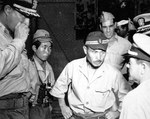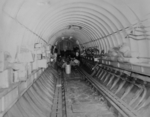![I-400 file photo [6294] I-400 file photo [6294]](/images/ship_i400_1.jpg)
I-400
| Country | Japan |
| Ship Class | I-400-class Submarine |
| Builder | Kure Naval Arsenal |
| Commissioned | 30 Dec 1944 |
| Sunk | 4 Jun 1946 |
| Displacement | 5,223 tons standard; 6,560 tons submerged |
| Length | 400 feet |
| Beam | 39 feet |
| Draft | 23 feet |
| Machinery | Four diesel engines totalling 7,700hp, electric motors totalling 2,400hp |
| Speed | 18 knots |
| Range | 37,500nm at 14 knots |
| Crew | 157 |
| Armament | 8x533mm forward torpedo tubes, 20x533mm Type 95 torpedoes, 1x140mm gun, 3x25mm machine guns, 1x25mm machine gun |
| Submerged Speed | 6.5 knots |
| Aircraft | 3 M6A Seiran seaplanes |
Contributor: C. Peter Chen
ww2dbaseSubmarine I-400 was the lead craft of her class of underwater aircraft carriers, capable of carrying up to three M6A Seiran seaplanes. Built at Kure, Japan, she (later joined by her sister submarines) became the largest submarine in the world, and would remain so until 1965. On 15 Dec 1944, Commander Toshio Kusaka was assigned as her commanding officer. On 30 Dec 1944, she was assigned to Submarine Division 1 of the Sixth Fleet. On 19 Mar 1945, she was strafed by American aircraft while in drydock at Kure, killing one anti-aircraft gunner. On 12 Apr, she departed Kure for Dairen, China, but was lightly damaged by a naval mine and had to return to Kure for repairs; she made the trip again on 14 Apr and made it to her destination successfully. She returned to Kure on 27 Apr. In May 1945, she was fitted with a breathing tube to allow her diesel engines to operate while she was submerged. In early Jun 1945, she conducted an exercise in Nanao Bay, launching six M6A Seiran aircraft operated by the 631st Naval Air Group.
ww2dbaseI-400 was originally designed to attack faraway targets such as American coastal cities or the Panama Canal, but by early Jun 1945 such a mission would mean little, thus a target much closer to Japan was chosen. On 20 Jul 1945, she was dispatched from Maizuru harbor during Operation Arashi in a force of two I-400-class submarines (I-400 and I-401, each carrying three aircraft) and two modified AM-class submarines (each carrying two aircraft) to attack the American anchorage at Ulithi in the Caroline Islands. On 22 Jul, she arrived at Ominato, Honshu, Japan, where all crew were granted one day's leave while all submarines in the group were painted with fake American markings. On the next day, she departed at 1400, taking a slightly different route toward Ulithi than the other submarines to avoid detection. Since the Japanese surrender was announced before the force reached their target, the mission was aborted on 18 Aug. All three I-400-class submarines fired their torpedoes and launched their aircraft into the water on 22 Aug 1945 before surrendering to the American destroyers USS Blue and USS Mansfield 500 miles northeast of Tokyo, Japan at 1200 on 27 Aug. At 0500 on 31 Aug, the American flag was raised above I-400 for the first time. The crew of I-400 later noted that in the subsequent weeks, American officers and sailors looted much from the captured Japanese submarine, ranging from novelties like the officers' swords, to valuable instruments like the submarine's compass, even to the ordinary sailors' razors.
ww2dbaseThe Americans never learned of the existence of the I-400-class submarines until their crews surrendered. I-400 and I-401 were studied by the United States Navy at Sasebo, Japan between 1 Nov and 11 Dec 1945 and then at the US Territory of Hawaii between 18 Feb and May 1946. As the Soviet Union demanded for a chance to study I-400, the Americans chose to scuttle I-400 rather than providing valuable information to the Soviets. She was sunk as a target ship off Kalaeloa near Oahu, Hawaii on 4 Jun 1946 by three torpedoes launched by submarine USS Trumpetfish.
ww2dbaseSources:
John Geoghegan, Operation Storm
Combinedfleet.com
Wikipedia
Last Major Revision: Aug 2008
Submarine I-400 Interactive Map
Photographs
 |  |  |  |
I-400 Operational Timeline
| 30 Dec 1944 | I-400 was commissioned into service. |
| 14 Apr 1945 | I-400 departed Kure, Japan for Dalian, China, disguised as a frigate complete with dummy naval guns and machine guns. She was tasked with bringing back fuel from the Dalian storage tanks. |
| 20 Apr 1945 | I-400 arrived at Dalian, China and began loading fuel. |
| 13 Jul 1945 | I-400 departed Nanao Bay and arrived at Maizuru, Japan. |
| 21 Jul 1945 | I-400 departed Maizuru, Japan. |
| 22 Jul 1945 | I-400 arrived at Mutsu, Japan. |
| 23 Jul 1945 | I-400 departed Mutsu, Japan. |
| 5 Aug 1945 | I-400 developed a electrical power while east of Saipan, Mariana Islands, which quickly developed into an electrical fire that caused the submarine to sink nearly out of control. The repairs took 5 hours to complete. The crew thought that they had surfaced just in time before they ran out of oxygen. |
| 13 Aug 1945 | I-400 reached the location south of Ulithi, Caroline Islands and waited for I-401 to arrive; her commanding officer did not realize that the rendezvous point had changed to another location 1,000 miles to the west. |
| 15 Aug 1945 | I-401 received conflicting orders, one from Emperor Showa ordering her to surrender in the form of the radio address, another from naval leadership ordering all submarines to carry out existing orders; Tatsunosuke Ariizumi, commanding officer of 6th Fleet who was aboard the submarine, chose to follow the latter. I-400, under Commander Toshio Kusaka, opted to obey the order to surrender. |
| 26 Aug 1945 | I-400 dumped all of her ammunition and Seiran aircraft overboard according to orders. |
| 27 Aug 1945 | I-400 was spotted in the Pacific Ocean by US Navy pilot Lieutenant Robert Mahoney flying a TBM Avenger aircraft. Commander Toshio Kusaka attempted to speed up to escape, but ultimately was ordered by his superiors to cooperate. |
| 28 Aug 1945 | Destroyers USS Blue and USS Mansfield intercepted I-400, which was discovered on the previous day, in the Pacific Ocean. USS Blue sent a 37-man boarding party and secured the submarine. Destroyer USS Weaver of US 20th Submarine Squadron arrived on the scene later, however, and forcibly took over the situation, claiming authority due to the personnel's submarine expertise. |
| 11 Dec 1945 | I-400 departed Sasebo, Japan. |
| 19 Dec 1945 | I-400 arrived at Guam, Mariana Islands. |
| 6 Jan 1946 | I-400 arrived at Pearl Harbor, US Territory of Hawaii. |
| 4 Jun 1946 | I-400 was scuttled by torpedoes from USS Trumpetfish off Oahu, US Territory of Hawaii. |
Please consider supporting us on Patreon. Even $1 per month will go a long way! Thank you. Please help us spread the word: Stay updated with WW2DB: |
Visitor Submitted Comments
28 May 2015 05:59:31 PM
Just noting, the page on the I-400 states incorrectly that the I-400 carried no gear to retrieve aircraft. It carried an unfoldable crane in the bows left of the catapult (if we are looking from the back)
tamiya's 1/350 model kit of it demonstrates this perfectly.
Other than that, nice site!
6 Mar 2016 12:14:45 PM
When was this article published?
18 May 2017 05:35:12 PM
How can I share some I-400 photos and additional info on this site?
All visitor submitted comments are opinions of those making the submissions and do not reflect views of WW2DB.
» Operation Storm
Partner Sites Content:
» Discovery of I-400
- » 1,163 biographies
- » 337 events
- » 44,601 timeline entries
- » 1,243 ships
- » 350 aircraft models
- » 207 vehicle models
- » 376 weapon models
- » 123 historical documents
- » 261 facilities
- » 470 book reviews
- » 28,632 photos
- » 429 maps
Joachim von Ribbentrop, German Foreign Minister, Aug 1939
Please consider supporting us on Patreon. Even $1 a month will go a long way. Thank you!
Or, please support us by purchasing some WW2DB merchandise at TeeSpring, Thank you!













10 May 2010 11:38:48 PM
type 400 japanesse sub. and type 21 german sub. infomation lacking. if you could show real interior plans it would mean a good deal more. thank you for your time.